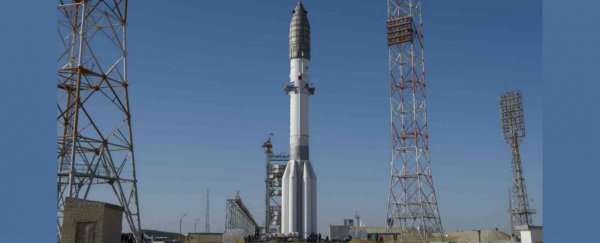A new mission to Mars will launch a spacecraft called ExoMars 2016 towards the red planet tonight, kickstarting a seven-month journey that will deliver a lander to the surface by October 19.
The European-led ExoMars team will launch the spacecraft atop a Russian Proton-M rocket from the Baikonur Cosmodrome in Kazakhstan at 5:31 am EDT (0931 GMT; 8:30pm AEST; 3:31 pm local Kazakhstan time) on Monday 14 March, and you can watch it all happen live below. Coverage starts an hour before takeoff.
The mission, which is being coordinated by the European Space Agency, plans to send two different spacecraft to Mars: the Trace Gas Orbiter (TGO), and a lander called Schiaparelli.
The TGO will float around the Martian atmosphere for the next five years, collecting data on the composition of gases it finds there. By studying the atmosphere of Mars in such detail, we'll not only get a better understanding of the planet itself, but we could also find hints about whether or not live exists on or below the surface.
"Essentially, our spacecraft is a giant nose in the sky," said ExoMars project scientist, Jorge Vago. "We are going to use it to sniff out the presence of methane on Mars and determine if it is being produced by biological processes."
As Robin McKie reports for The Guardian, methane is usually destroyed by ultraviolet radiation within a few hundred years of being released into the atmosphere, so if TGO was to detect some and confirms that it was biologically produced, it would suggest that life either exists on the red planet now, or did very recently.
But it's a long shot. NASA's Curiosity rover found no signs of methane in the Martian atmosphere back in 2012, and while a small amount was detected during a 2014 analysis of the data it beamed back, scientists have not been able to prove that it was produced from biological processes.
"On Earth most methane is generated biologically, but it can be made by chemical processes under the surface," McKie explains. "To differentiate between these two processes, the ExoMars trace gas detector will not only analyse methane levels in more detail than any previous mission but also study other gases that will provide information about its likely source."
TGO will also be responsible for mapping subterranean caches of hydrogen, which could be an indication of water-ice just below the surface.
The Schiaparelli lander, meanwhile, is scheduled to touchdown on the surface on October 19, and if successful, will act as a 'practice run' for a more sophisticated rover that will be launching some time in 2018 (budgets permitting) to search for Martian life.
This will be Europe's second mission to launch a spacecraft to Mars, and the first one in over a decade. Its first such mission launched the Mars Express orbiter and Beagle 2 lander towards Mars in June 2003, and while Mars Express remains comfortably in orbit today, the Beagle 2 lander quickly lost contact with mission control, but there are still signs of it on the Martian surface.
"Beagle 2 was recently spotted in images captured by NASA's Mars Reconnaissance Orbiter, suggesting that the lander touched down softly but failed to deploy all of its solar panels as planned," Mike Wall reports for Space.com.
These are exciting times, and you can watch it all live as it happens below. We'll post a reminder on Facebook an hour before launch, but set your alarms, just in case, and get ready to wake up at the crack of dawn if you're in the States, because it's not every day that you get to see a live rocket launch and the beginning of a brand new mission to Mars.
